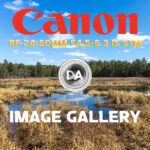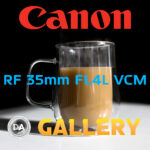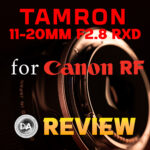
The most common lenses on the market tend to be those we call “kit” lenses for the simple reason that these are the lenses sold in bundle with certain cameras. Canon has a few of these type lenses for different classes of cameras. That might be an L-series lens like the RF 24-70mm F2.8L IS (my review here) or the RF 24-105mm F4L IS (my review here) as a premium upgrade, the 24-105mm F4-7.1 IS as a cheaper option, or, if you go for the least expensive option, this lens, the Canon RF 24-50mm F4.5-6.3 IS STM. It’s not just about price, however, as Canon released the RF 24-50mm alongside the EOS R8 in 2023 to be a smaller, lighter kit lens for what was Canon’s smallest and lightest full frame mirrorless camera. The retail price of the RF 24-50mm is $299 USD, but the price when bundled with the R8 drops to $200. This review is designed to help you decide whether it is worth the money. You can get my findings in the video review here, or keep reading.
Follow Me @ YouTube | Patreon | Instagram | Facebook | DA Merchandise | Flickr | 500px | X
__________________________________________________________________________________________________
Thanks to Camera Canada for sending me a review copy of this lens. As always, this is a completely independent review. All opinions and conclusions are my own. *I have done the majority of these tests on the Canon EOS R8, as this is the camera it is sold with for the moment.
__________________________________________________________________________________________________
Kit lenses need to be jack-of-all-trades, as they will sometimes be the only lens that a person owns. They will typically cover moderately wide (24mm here) to some kind of telephoto (a rather short 50mm, here). The 24-50mm has lens based stabilization (IS), which is important considering that the EOS R8 (or the EOS RP or EOS R) don’t have camera based stabilization. That helps considerably when shooting handheld video and moderately helps to make up for the very slow maximum aperture values available here.
- 24mm = F4.5
- 25-31mm = F5
- 32-38mm = F5.6
- 39-50mm = F6.3
In fact, the camera reported that the lens was still on 24mm when the maximum aperture closed to F5, so it isn’t even a full millimeter of zoom before you lose that maximum aperture of F4.5! Canon just BARELY avoided the aperture starting at F5. If you don’t understand what all of this aperture talk means, just know that this is a lens that is going to do best when there is plenty of light. Fortunately the EOS R8 has great high ISO performance, as you’ll often need to raise the ISO value in lower light situations when using this lens.

But frankly, this is a lens better suited to better light and brighter days. Get yourself one of Canon’s inexpensive prime lenses (like the 28mm F2.8 STM or the 50mm F1.8 STM) for those situations, and enjoy this lens for the areas where it works better.
Build and Handling
This isn’t a very large zoom range (slightly over 2x), but it does cover some important focal lengths (24, 28, 35, and 50mm). You can go from this at 24mm:

to this at 50mm:

That’s undoubtedly useful, though the question should be asked: would the Canon RF 24-105mm F4 IS STM be a better choice? It costs only $100 more and has a much bigger zoom range. The biggest reason to choose the RF 24-50mm seems to be size and weight. The RF 24-50mm is just 68.6mm in diameter (2.7″) and is 58.4mm (2.3″) in length. It weighs 210g (7.4oz). The RF 24-105mm IS STM is 76.6mm (3.0″) in diameter and 88.8mm (3.5″) in length, and weighs in at 395g (13.9oz). That’s far from being unusually large, obviously, but it is nearly twice as heavy and considerably larger.

The premium option here (pictured above) is the 24-105mm F4L IS, and it obviously dwarfs the much smaller 24-50mm. The 24-105L is a much better match to Canon’s larger bodies (like my EOS R5), while the 24-50mm is unquestionably a better balancing lens on the much smaller EOS R8.
Here’s a breakdown of the specs overall for the two cheaper kit lenses:

The RF 24-50mm achieves its smaller size in part by being a retractable zoom. It is less than 60mm for storage, but is unusable in that form.

On screen will be a warning to “Set the lens to the shooting position”, as the lens is incapable of proper focus in the retracted position.

The inner barrel will extend a significant amount (almost 30mm) to achieve the 24mm shooting position. Once extended, this is a “rocker” style zoom that is longest at 24mm, shortest near 35mm, then extends back out at 50mm, though not as far as at 24mm.



The build quality here isn’t bad. Everything is plastic, but feels reasonably tough. I own the RF 28mm F2.8 STM and 50mm F1.8 STM, and the build quality feels roughly similar to those lenses. Canon remains rigidly fixed to their design philosophy for their two “classes” of lenses (non L and L-series lenses), which means that no non-L lens receives weather sealing of any kind. Canon is also the only company I know of that still utilizes plastic mounts in some of its lenses. It just feels cheap.

Also standard for Canon is the fact that the lens hood is not included, despite the proliferation of sub $200 (and even sub $100) lenses on the market that do come with the lens hood included. The Canon spec EW-63C is a $25 accessory, though here’s a link to a Vello branded hood for $10. This policy seems remarkably petty in today’s marketplace, but I’ve also been saying that for years and obviously Canon doesn’t care!
There are two rings on the lens. The larger is the zoom ring. It moves smoothly once extended, but the action to either retract the lens or extend it from retraction feels clunky. The second ring is the control ring, which we’ll explore in a moment.

The lens does have two switches on the side. One is an ON | OFF for the stabilizer, while the other is a unique three position switch that allows you to choose between AF | CONTROL | MF. Essentially this is about the control of the second ring. Choose AF, and the ring does nothing. Choose Control, and this becomes a control point whose function can be assigned from within the camera. It could be an aperture ring, Exposure Compensation, or any number of other things. Choose MF, and, as you would expect, the control ring functions as a manual focus ring. The manual focus action is fairly good, actually, with nice weight and precision.

The two rings are close together, but the unique diamond texture of Canon’s control rings helps set it apart by feel. It’s a consistent touch on Canon’s lenses that I enjoy.

The lens has a matte finish with a few platinum colored accent rings that marry nicely to the similar color on the lens mount of the camera.
The aperture iris has 7 blades, and, as you can see from the photo below, these are not particularly rounded blades, so maintaining a circular aperture shape is not a strength.

Perhaps not a big deal, as there will be few opportunities to stop this lens down and get much out of focus anyway!
Up front we have a common 58mm front filter thread.

The highest magnification here comes on the telephoto end where it can focus as closely as 30cm (11.8″) and produces a useful 0.19x magnification.

This is useful, but not nearly as useful as the 0.50x figure achievable by the 24-105mm IS STM lens.
The IS (Image Stabilization) system here is rated for 4.5 stops of assistance and up to 7 stops when used in conjunction with a camera equipped with IBIS. I primarily tested it on the Canon EOS R8 (no IBIS), and found that I was able to get stable handheld video footage along with some assistance with handholding lower shutter speeds for stills, though I find there’s always a practical limit to how long you can go before you get some shake.
The build and handling here are largely what I would expect. Nothing feels premium, but everything feels reasonably tough and functional. Canon’s typical cost cutting measures with their non-L lenses are annoying, but nothing that is unique to this particular lens.
Autofocus and Video
Canon utilizes a lead-screw type STM (stepping motor) here, and it is a pretty solid implementation. Autofocus speed is quick and (mostly) quiet, with some light clicks and whirs during major focus changes. I found that my focus speed was snappy both indoors and outdoors, though you’ll see some minor slowdowns in extreme low light conditions.
Focus accuracy was good. Though this is hardly a top portrait lens choice, I did snap a few shots with it during a portrait session and got good looking, well focused results.


Depth of field is rarely very shallow when your maximum focal length is 50mm and your maximum aperture F6.3, but I could get well focused results on this rare moments when some things were out of focus.

I really liked the focus motor’s performance during my focus pulls. There was a high degree of confidence, and rather than snapping back and forth the focus pulls are smooth and well damped. I would say that this lens is perhaps more useful for video than it is for stills in many ways.
This is a lens that would work well as a gimbal lens. It’s small, lightweight, focuses well, and could work for gimbals or vlogging.
My hand test (where I alternately block the lens’ view of my face with my hand and then remove it) also went well so long as I gave the lens time to make its more sedate transitions. There is some moderate focus breathing, though some of Canon’s cameras will compensate for that in camera.
All in all, focus is solid here. That’s a definite strength for the lens.
Image Quality Breakdown
The RF 24-50mm sports an optical formula of 8 elements in 8 groups, and this includes two aspherical elements. Canon has shown a tendency to rely more on electronic rather than optical corrections in a number of their wide angle lenses, and we’ll see that unfortunate trend continue here.
At its best, the RF 24-50mm is capable of producing perfectly nice photos, but it is also true that there are a lot of deep optical flaws here. This is no “hidden gem” that dramatically exceeds its premise.

Starting with vignette and distortion. If you look at a corrected JPEG or RAW file, things don’t look too bad at 24mm.

But, as I mentioned, this is almost exclusively electronic correction. Here is what the uncorrected image looks like:

I’ve seen this far too often from Canon in the RF era. There is so much distortion that Canon is having to designed their lenses much wider than the stated focal length so that the electronic correction can try to bring it back to a semblance of normal. If I try to manually correct that, I have to max out the correction slider in Lightroom, which I’ve NEVER had to do before. There is still some barrel distortion after a 100% correction. I then would have to crop even further to get to the framing that I had on screen (I framed with the outside lines of the test chart up against the edges of the frame on the LCD).

That’s ridiculous.
I then also had to max out of the vignette correction slider (100%) to get to this end result, which is roughly similar to what the profile correction provided…which still doesn’t look all that great.

Frankly I’m a little offended by this. Canon has repeatedly told us that their new RF mount offers up so many new design advantages and opportunities, and yet so many of their RF wide angle lenses are worse in some of these areas than anything I ever saw on EF. I test lenses from at least a dozen different brands, and these are the worst results I am seeing from anyone.
Things improve as you zoom towards the 50mm end of things, and by 50mm there is still barrel distortion, but I could correct it with a more manageable +12 while dialing in a +52 (about two stops) of vignette correction.

In camera or in Canon DPP software you don’t even have the option of disabling the corrections…and you can see why. Software is doing a LOT of the heavy lifting here, which will have an impact on corner performance on the wide end as we’ll see in a moment.
Longitudinal chromatic aberrations (LoCA) are less common on a lens with such a small maximum aperture (the depth of field is almost never incredibly small), so while there is some fringing when I torture test for it, there will be very few situations where you’ll see it in normal shooting.

Likewise there is some lateral chromatic aberrations (LaCA) near the edge of the frame, but nothing that can’t be easily fixed by corrections.

So how about resolution and contrast? I’ll primarily be testing this lens on the platform it is sold for (the EOS R8) with a quick peak on how it holds up on a higher resolution camera like the Canon EOS R5. Here’s the test chart:

You will note that the test chart looks a little “dingy” despite profile corrections. That’s a LOT of vignette to correct for.
Here are the roughly 200% crops from across the frame at 24mm, F4.5. This is on the 24MP Canon EOS R8:



At this resolution point the lens looks pretty decent. The sharpness profile is pretty consistent across the frame, with the mid frame standing out as looking the best. The copy I tested showed good centering and consistent results on both sides.
Stopping down to F5.6 does show some improved contrast and slightly better resolution. The lifting of the some of the vignette makes for a more consistent image. Better still is F8, as while resolution isn’t dramatically improved, the improved contrast and reduced vignette makes for the best looking image to this point.

Real world landscape images at F5.6 and F8 look fine, though the details don’t necessarily “pop” anywhere. Most owners of the lens would probably be happy with this, though.



F11 looks largely the same, but after F11 the image will slightly soften due to the effects of diffraction. Expect this impact to be much higher if you use a higher resolution camera.

Things are slightly improved at 28mm. The distortion and vignette aren’t as extreme, so the electronic corrections aren’t having to work quite as hard!

There’s a slight bit more total improvement as you stop the lens down, though again you can’t expect this lens to achieve L series levels of sharpness.
35mm is fairly similar, though just a few percentage points behind the performance at 28mm. When stopped down the results are acceptably sharp on the EOS R8:



Results are largely the same at 50mm. The slow maximum aperture of F6.3 means that F8 arrives only 2/3rds of a stop later, so there isn’t a lot of stopping down options. There is a slight improvement by F8:

I did a comparison test on the EOS R5 (45MP) and found, to my surprise, that the RF 24-50mm did okay in that transition. Rather than looking softer, the high resolution sensor exposed more detail and I actually preferred the higher resolution result.

Resolution is not really the problem here. This lens is fairly sharp and consistent throughout the zoom range.
Flare resistance was a bit of mixed bag. Shooting directly into the sun wasn’t bad. There’s a few ghosting blobs, but nothing too bad. You’ll notice that the wide open sunstar (on the left) is rather weird, but the stopped down, F11 result on the right is pretty decent.

I noticed more of an issue with veiling (loss of contrast) when the sun was right out of the frame.


This is the kind of situation where a lens hood might help…now if only Canon included one!
I had fairly low expectations for bokeh with a lens like this. It has little capacity for producing much subject separation, as the maximum aperture is small, the minimum focus distance is fairly long, and the maximum focal length is only 50mm. That leaves quite a bit in focus at all times, and you can see here that the bokeh isn’t terrible, but it is busy and there is some definite distortion of specular highlights into lemon shapes along the edges of the frame.

This snowy image works a little better largely because the specular highlights aren’t very, ahem, highlighted in the overcast conditions.

If producing bokeh is your priority, then skip this lens and buy the inexpensive RF 50mm F1.8.
Reasonable sharpness is the best optical quality here, but the distortion and vignette at 24mm is amongst the worst I’ve ever seen. The RF 24-50mm is a hard sell from a purely optical standpoint. You can see more images in the gallery here.
Conclusion
The Canon RF 24-50mm F4.5-6.3 IS STM serves a specific purpose, namely to provide a small, lightweight, inexpensive lens for people to add to their Canon EOS R8 (and future cameras) so that they have a lens to actually take pictures with. I remember my first Canon DSLR purchase (the Rebel T1i) and it came with an EF-S 18-55mm IS lens. I didn’t love the lens (sold it fairly quickly), but it gave me something to use in the first couple of months so that I could use my new camera. There are places where Canon has improved things (autofocus is definitely better), but there are also some really frustrating areas of regression. Canon’s maximum aperture range on these type lenses has become decidedly worse, as Canon clearly banks on the improved ISO performance in modern cameras covering for the slower maximum apertures. They’ve also become increasingly reliant on software to cover for the hardware shortcomings, with massive amounts of optical correction needed to make the image usable.

I find it hard to recommend the RF 24-50mm to someone lens shopping for an existing camera, so the question is whether it is worth purchasing in kit with the EOS R8 or future bodies. One pro is that the lens adds image stabilization, and that will be particularly beneficial if you want to shoot some handheld video. It also has very solid autofocus for both stills and video, so at the least you should get reliably focused results. Best case scenario might be as a light, inexpensive gimbal lens.

But during my time with the EOS R8 I found that I preferred to just use the even smaller, much higher performing Canon RF 28mm F2.8 STM that is similarly priced and just zoom with my feet. Your mileage may vary, obviously, and there are applications where the RF 24-50mm will do just fine. If you value versatility, you might want to consider the RF 24-105mm F4-7.1 IS STM instead. It’s only $100 more expensive and offers up a much larger zoom range and has a faster maximum aperture over the shared focal lengths.
Pros:
- Has IS
- Compact and lightweight
- Good autofocus performance
- Reasonably sharp throughout the zoom range
- Has Canon’s useful control ring option with a decent implementation
Cons:
- Obscene amounts of vignette and distortion at 24mm
- Some flare issues and no included lens hood
- Retractable zoom is a pain, and the mechanical process is not refined
- Extremely slow maximum apertures
_________________________________________________________________________
GEAR USED:
Purchase the Canon RF 24-50mm IS @ Camera Canada | B&H Photo | Adorama | Amazon | Amazon Canada | Amazon UK | Amazon Germany
_______________________________________________________________
Purchase the Canon EOS R8 @ Camera Canada | B&H Photo | Adorama | Amazon | Amazon Canada | Amazon UK | Amazon Germany
___________________________________________________________________
Purchase the Canon RF 28mm F2.8 @ Camera Canada | B&H Photo | Adorama | Amazon | Amazon Canada | Amazon UK | Amazon Germany
_________________________________________________________________
Want to support this channel? Use these affiliate links to shop at: B&H Photo | Amazon | Adorama | Camera Canada | Amazon Canada | Amazon UK | Ebay | Make a donation via Paypal
Buy DA Merchandise https://bit.ly/TWIMerch

Keywords: Canon, Canon RF 24-50mm, 24-50mm, F4.5-6.3, IS, STM, Canon EOS R8, EOS, R, R5, Review, R8, RF, mirrorless, Canon EOS R7 Review, Sports, Tracking, Dustin Abbott, Real World, Comparison, Handling, Focus, Portraits, Resolution, High ISO, Image Quality, Sample Images, Photography, 45MP, 24MP, Canon, #letthelightin, #DA, #EOSR8, #Canon










